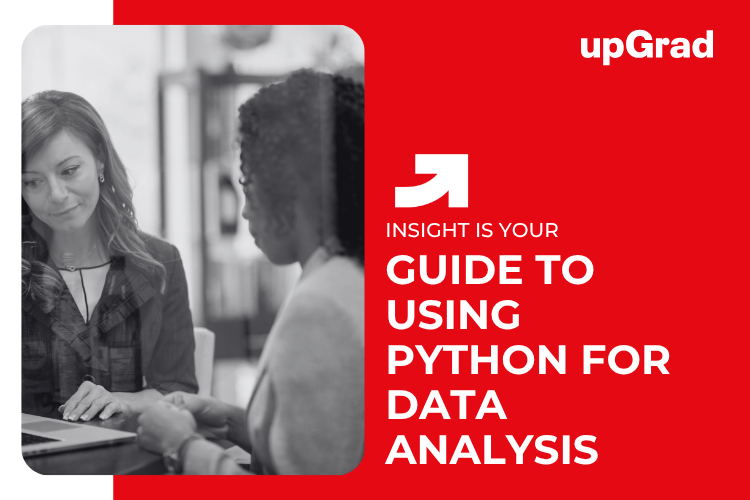In this data-driven era, organizations rely on data professionals to interpret and analyze complex data, enabling them to make informed, logical decisions. All industries, including healthcare, Finance, Logistics, and retail, utilize data analysis to achieve a smoother workflow.
Python for data analysis is one of the most user-friendly programming languages, and as a result, it is widely used. This has created an increased demand for Python Data Science courses.
According to Statista, nearly 54% of professionals worldwide use Python for data analysis. Several universities across the US have begun offering online Python Data Science courses, providing students with easy flexibility for learning.
This blog will guide you on how to use Python for data analysis, advanced techniques, and how upGrad can help in this journey.
How to Use Python for Data Analysis Efficiently
Python is one of the most frequently used programming languages for data analysis due to its ease of use. For efficient data analysis, it is essential to have a good understanding of Python libraries. Let’s have a look at the different Python libraries and their features.
| Library | Purpose | Features |
| Pandas | Data manipulation | Ideal for cleaning data |
| NumPy | Numerical computing | Fast array operations Lays the foundation for other libraries |
| Matplotlib | Data visualization | Creates plots to visualize insights |
| Scikit-Learn | Machine Learning | Performs predictive analytics tasks |
Also read: Master of Science in Data Science vs Data Analytics
Setting Up Python for Data Analysis
The first step in setting up Python for data analysis is setting up a suitable environment. The preferred environment in the US is Anaconda, which includes Python, along with libraries such as NumPy and Pandas.
Steps for setting up Python are:
- Go to anaconda.com and download Anaconda.
- Install Jupyter Notebook.
- Install Python libraries.
Cleaning and Preparing Data
Before starting the data analysis process, the data should be cleaned and structured. Data discrepancies should be identified and corrected to ensure the data is organized effectively. Clean data reduces the chances of error and helps in getting accurate insights.
It can be done by following the steps below:
- Identifying and removing data discrepancies
- Standardizing and normalizing data
- Validating and quality checks
Exploratory Data Analysis (EDA)
EDA is a very crucial step in data analysis as it helps in understanding the trends, anomalies, and features of the dataset. It involves various techniques that analyze data to inform subsequent analyses.
EDA involves the following steps:
- Creating a data summary
- Visualizing data
- Examining the correlation between variables
Applying Statistical Methods
Statistical analysis involves a systematic process that helps in understanding the patterns and relationships in your data. This method requires specific tools for efficient results.
The steps involved in this process are:
- Formulating hypotheses
- Applying Descriptive and Inferential Statistics
- Interpreting the data and communicating
Automating Data Analysis with Python
Automation is a technological advancement that helps save time and ensures consistent analysis. Python is flexible, which makes it easy to automate workflows that comply with US business standards.
It includes the following steps:
- Writing reusable functions.
- Using scheduling tools.
- Generating automated reports.
Also read: Data Science for Business: Real-world applications across industries in the US.
Advanced Techniques in Python for Data Analysis
Python offers a wide range of tools for numerous functions that are helpful when working with large datasets. Some of the advanced techniques are:
- Machine Learning Integration helps in building models, classifying data, and identifying patterns. It can be accomplished with the help of libraries such as Scikit-Learn, TensorFlow, or PyTorch.
- Python has ample tools for handling big data by using libraries.
- Python is capable of solving real-world problems across various sectors, including Finance, Retail, Healthcare, and other settings.
Also Read: Must-Know Big Data Tools for Data Engineers in the U.S.
Elevate Your Data Analysis Skills with upGrad
If you want to learn Python for Data Analysis, upGrad can help you by offering online courses from reputed universities. Explore various Data Science courses available for US students on our platform.
- Master of Science in Data Science by Liverpool John Moores University
- Executive Diploma in Data Science and AI by IIIT-B
🎓 Explore Our Top-Rated Courses in United States
Take the next step in your career with industry-relevant online courses designed for working professionals in the United States.
FAQs on Guide to Using Python for Data Analysis
Q: What makes Python better than Excel for data analysis?
Ans: Python is a better choice than Excel for data analysis because it is:
- Easy to use.
- Can handle complex and large data sets.
- Offers extensive libraries.
Q: Is Python safe for handling consumer data under U.S. privacy laws?
Ans: Yes, Python is safe for handling consumer data under U.S privacy laws. However, it depends on how the data is handled, stored, and processed.
Q: What are some real-world applications of Python in data analysis?
Ans: Some real-world applications of Python for data analysis are:
- Financial analysis.
- Cybersecurity.
- Sports analytics.
Q: What are the best Python libraries for data analysis?
Ans: Some of the best Python libraries for data analysis are:
- Pandas.
- NumPy.
- Scikit-Learn.
Q: Is Python suitable for beginners in data analysis?
Ans: Yes, Python is suitable for beginners in data analysis because of:
- Numerous libraries.
- Ease of use.
- Readability.









